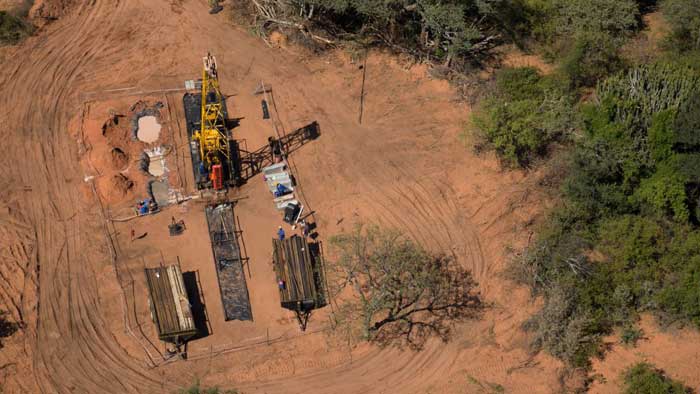VANCOUVER — The resource at developer Platinum Group Metals’ (TSX: PTM, NYSE-MKT: PLG) Waterberg platinum group metals discovery on the North Limb of the Bushveld igneous complex in South Africa just keeps growing. A new, expanded resource update for Waterberg’s T and F layers may even change the project’s development path and economics.
Waterberg is comprised of two assets: the Waterberg joint venture, where Platinum Group holds a 37% interest alongside 37% partner Japan Oil, Gas and Metals National (JOGMEC) and 26% partner Mnombo Wethu Consultants, a private empowerment group; and the Waterberg Extension, where Platinum Group has an 87% stake alongside Mnombo Wethu.
Waterberg has discrete, layered and continuous platinum group metals mineralization starting at 140 metres depth with a consistent westerly dip. The deposit has been drilled 10.4 km northwards along strike, with geophysical surveying and drilling indicating that it remains open downdip and on strike to the northwest. The observed deposit layers are 2.8 to 60 metres thick, with a well-identified and modelled rock unit and geochemical markers.
Platinum Group tabled a preliminary economic assessment (PEA) at the Waterberg JV in February, but the study was modelled on a smaller resource that did not include any mineralization from the newly defined Waterberg Extension. As a result, Platinum Group and its partners are deciding whether to unify the deposits into a single operation, which could boost operating efficiency.
“We’ve really added an entire second deposit with the announcement.” Platinum Group president and CEO Michael Jones said during a conference call.
He noted that a potential sale of JOGMEC’s interest in the JV has been deferred until the entire project scale can be considered.
“It’s quite complicated to decide whether to make these stand-alone mines, and how you plan the infrastructure,” Jones said. “It will make a substantial difference, and there is considerable synergy in potentially unitizing the entire deposit.”
Waterberg’s overall tonnage has increased by 72% since the last estimate was released in October 2013.
The PEA was based on 167 million inferred tonnes grading 0.98 gram platinum per tonne, 1.97 grams palladium per tonne and 0.32 gram gold per tonne.
Platinum Group’s new resource boosts the total to 287 million inferred tonnes grading 0.94 gram platinum, 1.92 grams palladium, 0.25 gram gold and 0.04% rhodium. The rhodium included in the new estimate could improve economic returns.
The initial PEA contemplated a US$885-million operation that would crank out 665,000 oz. platinum, palladium and gold (3E) at production costs of US$438 per oz. that include copper and nickel by-product credits. The concept carried a 14% post-tax internal rate of return and a US$509-million post-tax new present value.
“Waterberg is one of the top copper–nickel–platinum group metal deposits in the world, and we’re not done yet,” Jones said.
“We think the discovery is opportune insomuch as it was made at the right time. It’s in a market that’s going through restructuring and re-planning, and it’s characteristics in terms of its ‘mineability,’ large-scale mechanized mining methods, and labour component will be important moving forward. We see lots of potential to expand the scale and thereby work on unit costs.”
It looks as though Platinum Group’s work on the Waterberg Extension is about to hit high gear, as the company moves its drills to an extension farther north called “Waterberg 3.”
Jones and his team hope northern exploration will unearth the “M Layer,” which the company says could be the real “heart” of the deposit.
For example, in late 2012 the company reported that hole 7, which was collared 4.7 km north of the Waterberg JV, cut 2.8 metres of 0.78 gram platinum, 1.67 grams palladium and 0.14 gram gold from 741 metres depth.
The company said finding F-zone mineralization that far north was “a significant milestone.”
Jones acknowledged that the platinum industry is in flux owing to the strike in the first half of the year by platinum miners at major South African mines run by Anglo American (LSE: AAL; US-OTC: AAUKY) subsidiary Anglo American Platinum, Impala Platinum (LSE: IPLA) and Lonmin (LSE: LMI).
Jones commented that the strike “changed the historic nature of the industry and really tightened the platinum and palladium markets.” He added that “the strategic decisions moving forward — particularly on deep, marginal shafts — will be different than they were before the strike.”
Platinum Group shares gained 8% after the Waterberg resource update, en route to a $1.31-per-share close on June 12.
Shares have traded within a 52-week range of 87¢ to $1.49.
The company had 551.3-million shares outstanding at press time for a $695-million market capitalization.


Be the first to comment on "Platinum Group boosts resources at Waterberg"